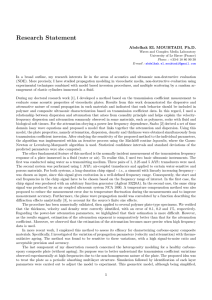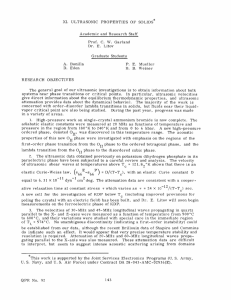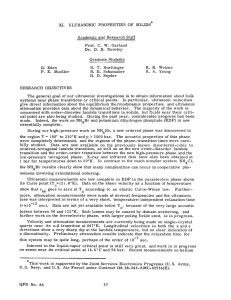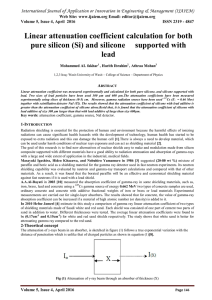X. TRANSPORT PHENOMENA IN SOLIDS
advertisement
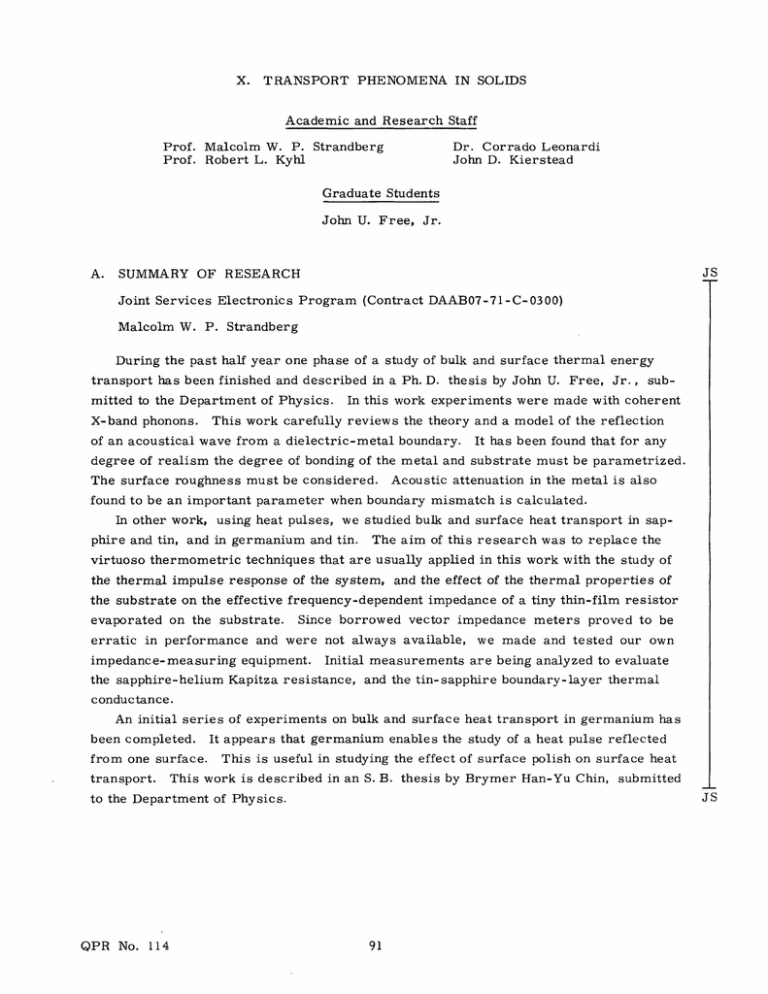
X. TRANSPORT PHENOMENA IN SOLIDS Academic and Research Staff Dr. Corrado Leonardi John D. Kierstead Prof. Malcolm W. P. Strandberg Prof. Robert L. Kyhl Graduate Students John U. Free, Jr. A. JS SUMMARY OF RESEARCH Joint Services Electronics Program (Contract DAAB07-71-C-0300) Malcolm W. P. Strandberg During the past half year one phase of a study of bulk and surface thermal energy transport has been finished and described in a Ph. D. thesis by John U. Free, Jr., mitted to the Department of Physics. X-band phonons. sub- In this work experiments were made with coherent This work carefully reviews the theory and a model of the reflection of an acoustical wave from a dielectric-metal boundary. It has been found that for any degree of realism the degree of bonding of the metal and substrate must be parametrized. The surface roughness must be considered. Acoustic attenuation in the metal is also found to be an important parameter when boundary mismatch is calculated. In other work, using heat pulses, we studied bulk and surface heat transport in sapphire and tin, and in germanium and tin. The aim of this research was to replace the virtuoso thermometric techniques that are usually applied in this work with the study of the thermal impulse response of the system, and the effect of the thermal properties of the substrate on the effective frequency-dependent impedance of a tiny thin-film resistor evaporated on the substrate. Since borrowed vector impedance meters proved to be erratic in performance and were not always available, impedance-measuring equipment. we made and tested our own Initial measurements are being analyzed to evaluate the sapphire-helium Kapitza resistance, and the tin-sapphire boundary-layer thermal conductance. An initial series of experiments on bulk and surface heat transport in germanium has been completed. from one surface. transport. It appears that germanium enables the study of a heat pulse reflected This is useful in studying the effect of surface polish on surface heat This work is described in an S. B. thesis by Brymer Han-Yu Chin, submitted to the Department of Physics. QPR No. 114 JS (X. JS B. TRANSPORT PHENOMENA IN SOLIDS) ATTENUATION OF COHERENT MICROWAVE PHONONS IN THIN METAL FILMS John U. Free, Jr. This report summarizes a thesis submitted to the Department of Physics, M. I. T., on February 28, 1974, in partial fulfillment of the requirements for the degree of Doctor of Philosophy. A new technique for the measurement of ultrasonic attenuation in metals in the gigahertz range is described. The method used in this research is to evaporate a thin metal- lic film onto the end of a quartz rod transducer and measure the ultrasonic wave reflected from the thin film. This method obviates the normal difficulties encountered in producing a thin flat metal sample and in bonding the sample to the ultrasonic transducer. The advantages of this technique over the conventional reflection or transmission methods are twofold. First, ultrasonic attenuation measurements can be made at higher frequencies than before. Second, this method enables measurement of ultrasonic reflection coef- ficients and residual attenuation coefficients, as well as of the electronic attenuation coefficient. The ultrasonic reflection-coefficient measurements make a valuable contribution to experimental work in thermal boundary resistance. The theory for the reflection of an acoustical wave from a plane boundary is reviewed and extended to include such nonideal features as a rough interface, bubbles on the interface, and one medium having a large acoustical attenuation. The theory of an acoustical wave reflected from two interfaces or a thin film is then developed. The effects of a non- ideal thin film are discussed. Results are reported for evaporated tin samples. samples. Measurements were made on 12 The experiments were carried out over an 8. 9-9. 4 GHz frequency range at liquid-helium temperatures. The nature of the experiment and the relationship between physical parameters such as the reflection coefficient and the residual attenuation coefficient made the absolute determination of the parameters impossible. ical parameters were determined within some range of values. Hence the phys- Analysis of the data indicated close agreement with the theory of Pippard for the electronic attenuation coefficient. The electronic attenuation coefficient is consistent in both magnitude and fre- quency dependence. The residual attenuation was found to be due mainly to grain boundary scattering and is in agreement with the results of Splitt. The ultrasonic longitudinal reflection coefficient between quartz and tin was found to be 0. 35 ± 0. 15. This value is in agreement with the value calculated by using the mismatch theory and with measurements made at lower frequencies. Finally, the ultrasonic longitudinal velocity in this tin was measured and found to be approximately 10% less than in bulk tin at lower frequencies. JS This is consistent with the fact that the density of evaporated tin is less than that of bulk tin. QPR No. 114 (X. C. TRANSPORT PHENOMENA IN SOLIDS) JS ON THE PROPAGATION OF HEAT PULSES IN GERMANIUM Brymer Han-Yu Chin This report summarizes a thesis submitted to the Department of Physics, M. I. T., on May 16, 1974, in partial fulfillment of the requirements for the degree of Bachelor of Science. The high sensitivity and fast response of thin-film, superconducting bolometers have made heat-pulse studies in solids at liquid-helium temperatures an important area of solid-state research. studies. We present the basic theory and experimental techniques for such We discuss in detail data for heat-pulse propagation along the [ 111] direction of germanium. In our work, 3 pulses were observed. Two pulses correspond to the pure longitudinal and quasi-transverse modes predicted from elastic wave theory. alous third pulse is interpreted as a reflection from the sample boundaries. QPR No. 114 The anomJS
